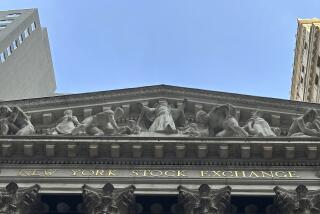Stocks of Small Southland Firms on OTC Pounded
In this stock market, the rich aren’t getting richer, but the poor are getting poorer.
The market’s poorest stocks--mostly smaller over-the-counter issues that performed badly in 1990--have been slammed even lower since the new year began.
And for unexplained reasons, Los Angeles-region OTC stocks have suffered far worse than their peers in other major U.S. cities. Maybe the Southland’s deep involvement in Operation Desert Shield is having a much more depressive effect on investors here than is widely believed.
The weight of the evidence:
* As the chart at right shows, such L.A. stocks as lamp maker Dynasty Classics, apparel firm Quiksilver and electronics distributor Bell Industries all have been hit for new losses of more than 15% just since 1991 began. All of the stocks ended 1990 down steeply from their highs.
* A stock index composed solely of L.A.-area OTC stocks has fallen 4.8% so far this year, to 86.03, according to the National Assn. of Securities Dealers. The NASD, which compiles the L.A. index, also has indexes for four other major cities, and none is down as much as L.A.’s: The Washington index is off 3.2%, Chicago and New York both are off 2.1%, and San Francisco is down just 0.3%.
Trading in the smallest OTC stocks is mostly the domain of individual investors, rather than institutional investors such as pension funds. So the heavy selling of many of these stocks has to be laid to individuals’ collective decision to get out.
But why now--when the stocks already have been so beaten up?
James Alexander, whose J. Alexander Securities brokerage in L.A. specializes in stocks of smaller area companies, says most of his clients have only one thing on their minds: the oncoming U.S.-Iraq war. That’s the only issue they’re talking about, he says, and “on balance they are for sure looking to be sellers, not buyers” of stocks because of it.
And area stockbrokers, many also apparently afraid of the consequences of war, finally have stopped trying to persuade their clients to hold on, traders say. “I see a lot of (sales) tickets from brokers who have given up the fight,” says Will Porter, over-the-counter stock trading chief at Cruttenden & Co. in Newport Beach.
When the sellers try to get out, however, they often find there are few takers for their shares, brokers say. As more investors have exited small stocks, that market has become terribly illiquid. So even a small trade now can move an OTC stock’s price dramatically.
“I’ve seen more price gaps on trades of just 1,000 or 2,000 shares than at any time in my career,” says veteran Alexander. A “gap” occurs when a stock trades in a range that doesn’t even overlap the previous day’s range--in other words, a stock might trade on Wednesday in a range of $5 to $6, then on Thursday in a range of $3.50 to $4.50.
But some traders say the recent plunge in the prices of many small stocks isn’t solely a factor of individual investor selling. Brokerages themselves have been marking down OTC prices even without significant selling, argues Steven Wallace, head of discount brokerage Pacific Brokerage Services in Los Angeles.
The brokerages, many of which are expected to maintain an inventory of small OTC stocks so they can quickly buy from or sell to clients, increasingly are trying to avoid getting stuck with stock that they in turn won’t be able to unload on anyone else, some traders say. So the firms are lowering the prices they’re willing to pay.
“You see stocks go down a point and no shares have changed hands,” Wallace says. And that, he says, “breeds even more selling.”
Wallace’s firm is one of a growing number of brokerages that have simply stopped keeping inventories of OTC stocks because the business has become a loser as OTC stocks have slumped badly over the past 18 months. As prices drop, so does the value of a brokerage’s inventory. “The OTC dealers are just getting killed,” Wallace says.
Where does all of this lead? In the Southland, where individual investors already appear to be taking a far more pessimistic view of the coming war than investors elsewhere, the scene may be set for an even deeper plunge in small-stock prices.
But investors also ought to keep the longer-term outlook in mind: Not all of these small companies are going out of business. Certainly, the most depressed of the lot are down for a good reason--their earnings outlook may be bleak in the recession. But if the economy recovers later this year, these stocks could rocket higher just as quickly as they’ve plummeted.
Remember, an illiquid market works both ways--you can’t sell the stocks easily on the way down, but neither will you be able to get in easily once they take off again.
Briefly: The revolving door continues at L.A. brokerage Bateman Eichler, Hill Richards. Kemper Corp., the Chicago-based parent, has placed Bateman President Allan Sher in charge of all Western retail brokerage operations for Bateman and its sister brokerage firms Boettcher & Co. (Denver) and Lovett Underwood (Houston). Sher, who just took over Bateman last June, will remain based in L.A. Meanwhile, Kemper expects to name a new “divisional sales manager” to replace Sher at Bateman in a week or so, says Kemper spokesman Steve Radis.
Bateman and its sister brokerages used to operate fairly independently. But faced with mounting costs and shrinking revenue in the bear market, Kemper has retaken control of the brokerage units over the past six months, centralizing decision-making in Chicago. Many administrative employees of Bateman have lost their jobs. The work force was cut 15% last year, most of that in the fourth quarter.
Meanwhile, Burland East, an analyst who had covered stocks of real estate companies for Bateman, has left to become a money manager for Industrial Equity Pacific in La Jolla. The $500-million fund is an arm of New Zealand investor Ron Brierley’s empire.
KNOCK ‘EM WHEN THEY’RE DOWN Some of the depressed small Southland stocks of 1990 have gotten much more depressed since the new year began. A sampling:
52-week Thurs. Chg. since Stock high/low close Dec. 31 Dynasty Classics 18 3/4-3 1/4 3 1/2 -33% Quiksilver 30-9 5/8 11 1/2 -21% FHP Intl. 22-9 3/4 12 -21% Barry’s Jewelers 12-1 3/4 2 -20% Rexon 9 7/8-4 5 5/8 -20% Bell Indus. 18 3/4-12 11 -19% CU Bancorp 11 1/4-7 7 1/2 -17% K Swiss 30 1/4-10 1/2 14 3/8 -15% Optical Radiation 39 1/4-20 1/4 21 1/2 -14% OTC compos. indx. 470-325 361.92 -3%
All traded OTC except Bell Indus. (NYSE)
More to Read
Inside the business of entertainment
The Wide Shot brings you news, analysis and insights on everything from streaming wars to production — and what it all means for the future.
You may occasionally receive promotional content from the Los Angeles Times.










